Scottish Crime and Justice Survey 2019/20: main findings
Main findings from the Scottish Crime and Justice Survey 2019/2020, including self-completion findings covering the period 2018/19 to 2019/20.
This document is part of a collection
9.4 Sexual Victimisation
SCJS respondents are asked about their experiences of serious sexual assault and less serious sexual assault, since the age of 16 and in the 12 months prior to interview.
The survey asks respondents if they have experienced one or more of the following types of serious and less serious sexual assault:[163]
Serious sexual assault
- Forced sexual intercourse
- Attempted forced sexual intercourse
- Forced other sexual activity (for example, oral sex)
- Attempted forced other sexual activity
Less serious sexual assault
- Unwanted sexual touching
- Indecent exposure
- Sexual threats
There may be some overlap between the incidents of sexual victimisation presented in this section, and the incidents of stalking and harassment and partner abuse discussed elsewhere in this report, as these experiences can involve similar behaviours. It is also possible that some sexual victimisation incidents presented in this section constituted partner abuse and/or stalking and harassment but were not viewed or reported during the survey as such by respondents.
The figures in this section refer to the two survey years 2018/19 and 2019/20 combined. This is referred to throughout the section as 2018/20. For more information, see the Technical Report.
Serious Sexual Assault
This section focuses mainly on respondents who reported at least one form of serious sexual assault since the age of 16, however prevalence of sexual assault in the 12 months prior to interview is also covered.
What can the 2018/20 SCJS results tell us about serious sexual assault in Scotland?
3.6% of adults in Scotland have experienced at least one type of serious sexual assault since the age of 16.
Overall, 3.6% of adults said they had experienced at least one type of serious sexual assault since the age of 16, whilst 1.6% of respondents had experienced more than one type of serious sexual assault.
Table 9.9 below shows the percentage of respondents who said they had experienced serious sexual assault since the age of 16 over time.
The latest results show there has been no change since 2008/09 in the proportion of respondents reporting experience of at least one type of serious sexual assault. When looking at the types of serious sexual assault experienced however, there has been an increase in the proportion of adults experiencing attempted forced sexual intercourse (from 1.5% to 2.0%) and attempted other forced sexual activity (from 0.7% to 1.3%). There was no statistically significant change in the proportion reporting the other two types.
There have been no statistically significant changes between 2016/18 and 2018/20 across any of the types of serious sexual assault.
| Type of serious sexual assault | 2008/09 | 2009/10 | 2010/11 | 2012/13 | 2014/15 | 2016/18 | 2018/20 | Percentage point change since 2008/09 |
|---|---|---|---|---|---|---|---|---|
| Forced sexual intercourse | 1.7% | 1.5% | 1.4% | 1.6% | 1.6% | 1.9% | 2.0% | No change |
| Attempted forced sexual intercourse | 1.5% | 1.2% | 1.3% | 1.1% | 1.2% | 1.6% | 2.0% | ↑ by 0.5 |
| Other forced sexual activity | 0.6% | 0.5% | 0.6% | 1.1% | 0.7% | 0.8% | 0.9% | No change |
| Attempted other forced sexual activity | 0.7% | 0.7% | 0.7% | 0.6% | 0.8% | 1.4% | 1.3% | ↑ by 0.5 |
| At least one form of serious sexual assault | 3.2% | 2.7% | 2.8% | 2.5% | 2.7% | 3.6% | 3.6% | No change |
| Number of respondents | 10,970 | 13,420 | 11,000 | 10,240 | 9,990 | 8,820 | 9,600 |
Base: All respondents. Variable: SA_0.
Less than 1% of adults in Scotland have experienced at least one type of serious sexual assault in the 12 months prior to interview.
0.3% of adults said they had experienced at least one type of serious sexual assault in the 12 months prior to interview.
This proportion, and the proportion of adults experiencing each type of serious sexual assault, have shown no change since 2008/09 and since 2016/18.
As there were only a small number of respondents who experienced serious sexual assault in the 12 months prior to interview,[164] the rest of the analysis in this section focuses on experiences since the age 16.
The first (or only) incident occurred between the ages of 16 and 20 for more than half of those who experienced serious sexual assault.
Respondents who experienced at least one incident of serious sexual assault since the age of 16 were asked at what age the first (or only) incident took place. Figure 9.13 below shows that the majority (55%) of respondents said the first (or only) incident took place between the ages of 16 and 20.
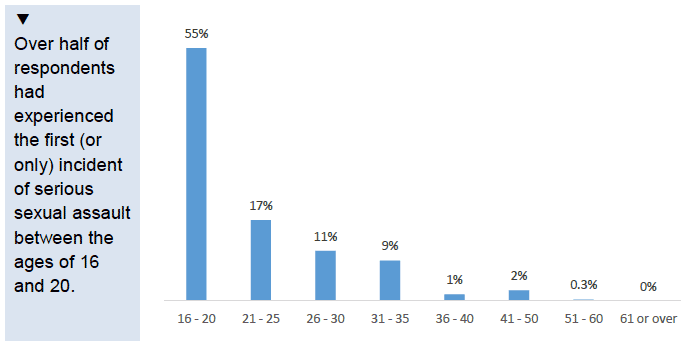
Base: All respondents who experienced at least one type of serious sexual assault since the age of 16 (370). Variable: SA_1.
Victims of serious sexual assault were likely to have experienced more than one incident.
Respondents who experienced a type of serious sexual assault were then asked how many incidents of that specific type they had experienced since the age of 16. Table 9.10 shows the incidence of serious sexual assault since the age of 16 for the four types of serious sexual assault.
It shows, for example, that of those respondents who had experienced forced sexual intercourse since the age of 16, 62% said they had experienced more than one incident. Just under half of those who had experienced more than one incident said they had experienced too many incidents to count (28% of all respondents who had experienced forced sexual intercourse since the age of 16).
| Number of incidents | Forced sexual intercourse | Attempted forced sexual intercourse | Other forced sexual activity | Attempted other forced sexual activity |
|---|---|---|---|---|
| One | 25% | 22% | 14% | 19% |
| More than one | 62% | 61% | 64% | 51% |
| Two | 15% | 16% | 9% | 12% |
| Three | 10% | 11% | 6% | 2% |
| Four | 4% | 3% | 3% | 6% |
| Five | 4% | 4% | 5% | 3% |
| Six and over | 1% | 1% | 2% | 0.4% |
| Too many to count | 28% | 26% | 40% | 27% |
| Number of respondents | 220 | 200 | 90 | 130 |
Base: All respondents who had experienced each form of serious sexual assault since age 16. Variables: FS_2EVER, AFS_2EVER, OS_2EVER, AOS_2EVER.
Note: 'don't know/can't remember' and 'don't wish to answer' responses are not shown.
What can the SCJS tell us about the nature, impact and reporting of serious sexual assault?
This section mainly focuses on experiences of forced sexual intercourse, however results for each of the four types of serious sexual assault can be found in the online data tables.
Most victims knew the offender in some way.
Respondents who had experienced each type of serious sexual assault were asked what their relationship to the perpetrator(s) had been at the time of the incident for all experiences since the age of 16. If there had been more than one perpetrator, the respondent was asked to record all of them.
Of those respondents who had experienced forced sexual intercourse since the age of 16, half (51%) said that the perpetrator had been their partner, whilst 14% said the perpetrator was an ex-partner.[165] Figure 9.14 below shows the results.
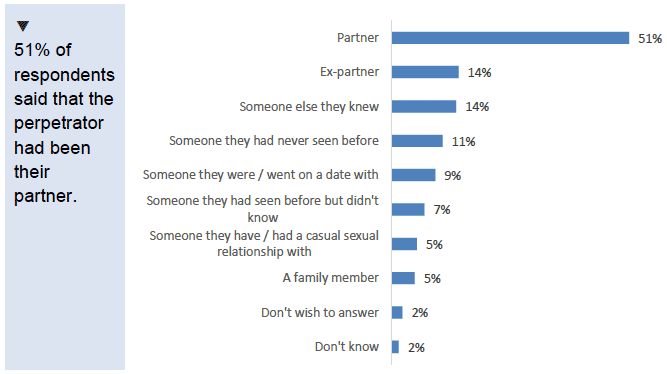
Base: All respondents who experienced forced sexual intercourse since the age of 16 (210). Variables: FS_3B4; FS_3.
The majority of those who had experienced forced sexual intercourse said that the latest (or only) incident had resulted in some form of physical impact.
Respondents who had experienced at least one incident of serious sexual assault since the age of 16, were asked about the physical impact of the latest (or only) incident.
Of those who had experienced forced sexual intercourse, 67% said that the last (or only) incident had resulted in some form of physical impact; either minor (37%), serious but not treated by a medical professional (22%) or serious and treated by a medical professional (13%). Just under one-in-ten (9%) said that the last (or only) incident had resulted in pregnancy.
In most cases, the most recent (or only) incident of serious sexual assault was not reported to the police.
Respondents who had experienced serious sexual assault since the age of 16 were asked if the police were informed about the most recent (or only) incident. Just over a fifth (22%) of respondents said the police came to know about the most recent (or only) incident of forced sexual intercourse.
Figure 9.15 shows reporting rates for the four types of serious sexual assault. Note that this is not the proportion of crimes reported in 2018/20 as the incident may have happened, and been reported to the police, at an earlier time. Compared to 2016/18, there was no significant change for any type of serious sexual assault.
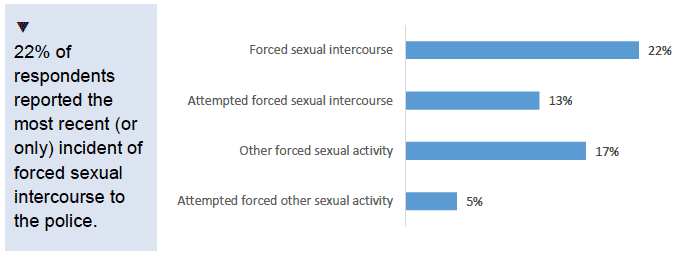
Base: All experiencing forced sexual intercourse since the age of 16 (210); all experiencing attempted forced sexual intercourse since the age of 16 (180); all experiencing other forced sexual activity since the age of 16 (70); all experiencing attempted other forced sexual activity since the age of 16 (100). Variables: FS_7; AFS_7; OS_7; AOS_7.
Respondents who said the police did not come to know about the most recent (or only) incident of serious sexual assault, since the age of 16, were asked the reasons for this. Figure 9.16 below shows the reasons for forced and attempted forced sexual intercourse (the two largest categories of serious sexual assault).
The most common reason for not informing the police of forced sexual intercourse was fear of making matters worse (47%), whilst the most common reasons for not reporting attempted forced sexual intercourse were fear of making matters worse (33%) and that they dealt with the matter themselves (30%).
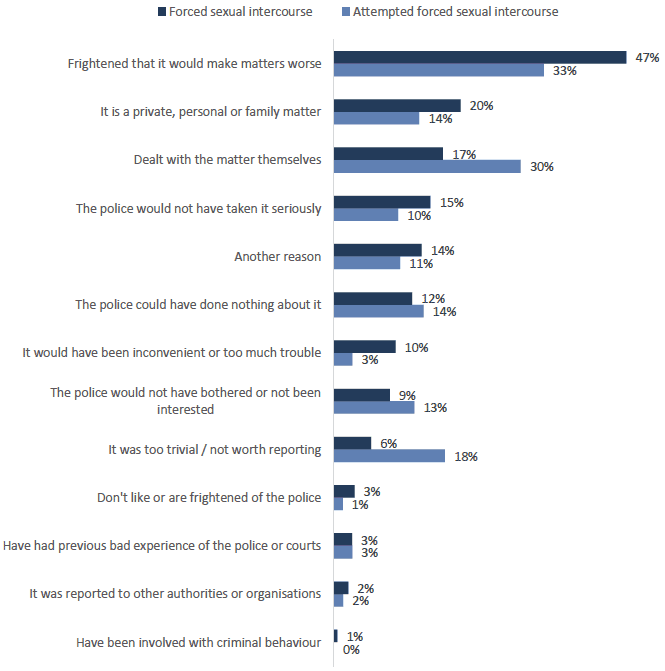
Base: All experiencing forced sexual intercourse since the age of 16 where police did not come to know about the most recent incident (160); all experiencing attempted forced sexual intercourse since the age of 16 where police did not come to know about the most recent incident (150). Variables: FS_7i; AFS_7i.
Are some population groups more likely to have experienced serious sexual assault?
Experience of serious sexual assault since the age of 16 varied by gender, age, and victim status.[166] Table 9.11 below shows the varying proportion of respondents reporting experience of at least one form of serious sexual assault since the age 16, by their characteristics.
Changes since 2008/09 are also discussed below where they have occurred, however most groups have shown no change and none of the groups have shown any change since 2016/18.
| Characteristics | % of adults | Base | |
|---|---|---|---|
| Gender | Male | 0.8% | 4,360 |
| Female | 6.1% | 5,240 | |
| Age | 16-24 | 4.8% | 680 |
| 25-44 | 4.8% | 2,750 | |
| 45-59 | 3.4% | 2,520 | |
| 60 and over | 2.0% | 3,650 | |
| Victim status | Victim | 7.1% | 1,060 |
| Non-victim | 3.1% | 8,540 | |
| Area deprivation | 15% most deprived | 4.9% | 1,310 |
| Rest of Scotland | 3.4% | 8,280 | |
| Rurality | Urban | 3.6% | 7,830 |
| Rural | 3.3% | 1,770 | |
| All adults | 3.6% | 9,600 |
Base: All respondents. Variable: SA_0.
Gender
A greater proportion of women than men have experienced serious sexual assault both since the age of 16 (6.1% compared with 0.8%) and in the 12 months prior to interview (0.4% compared with 0.1%).
Age
Respondents aged 60 and over were less likely to report having experienced serious sexual assault than all other age groups. However the proportion of those aged 60 and over experiencing serious sexual assault since the age of 16 has increased between 2008/09 and 2018/20 (from 1.2% to 2.0%). All other age groups have shown no change.
Victim status
Despite an increase in the proportion of non-victims experiencing serious sexual assault between 2008/09 and 2018/20 (from 2.5% to 3.1%), as in previous years victims of other types of crime remain more likely to be a victim of serious sexual assault. In 2018/20, of those who were classified as victims in the main SCJS survey, 7.1% had experienced at least one serious sexual assault since the age of 16, compared to 3.1% of non-victims.
Area deprivation
Those living in the 15% most deprived areas of Scotland were more likely to experience serious sexual assault than those living in the rest of Scotland (4.9%, compared to 3.4%).
Rurality
There was no statistically significant difference in the proportion who experienced serious sexual assault since the age of 16 depending on whether they lived in urban or rural areas. This is a consistent finding with previous results.
Less Serious Sexual Assault
This section focuses mainly on respondents who reported at least one form of less serious sexual assault since the age of 16, however it also includes some analysis of experiences in the 12 months prior to interview.
What can the 2018/20 SCJS results tell us about less serious sexual assault in Scotland?
One-in-ten adults have experienced at least one type of less serious sexual assault since the age of 16.
Respondents were asked if they had experienced three types of less serious sexual assault since the age of 16; these were unwanted sexual touching; indecent exposure; and sexual threats.
10.1% of all adults said they had experienced at least one type of less serious sexual assault since the age of 16, whilst 3.1% of respondents had experienced more than one type.
Since both 2008/09 and 2016/18, the SCJS has detected no change in the proportion of adults who said they have experienced at least one form of less serious assault since the age of 16.
Breaking the results down by type of sexual assault experienced, the latest results show an increase in the proportion of respondents reporting unwanted sexual touching between 2008/09 and 2018/20 (from 4.8% to 7.4%), with no change in the prevalence of sexual threats and a decrease in experiences of indecent exposure (from 5.0% to 3.9%). Table 9.12 below shows the results.
| Type of sexual assault | 2008/09 | 2009/10 | 2010/11 | 2012/13 | 2014/15 | 2016/18 | 2018/20 | Percentage point change | |
|---|---|---|---|---|---|---|---|---|---|
| Change since 2008/09 | Change since 2016/18 | ||||||||
| Unwanted sexual touching | 4.8% | 4.1% | 4.6% | 4.3% | 4.8% | 6.4% | 7.4% | ↑ by 2.6 | ↑ by 1.0 |
| Indecent exposure | 5.0% | 5.1% | 4.2% | 4.0% | 4.3% | 4.1% | 3.9% | ↓ by 1.0 | No change |
| Sexual threats | 2.1% | 1.9% | 1.9% | 1.8% | 2.1% | 2.6% | 2.7% | No change | No change |
| At least one form of less serious sexual assault | 9.4% | 8.8% | 8.3% | 7.6% | 8.3% | 9.3% | 10.1% | No change | No change |
| Number of respondents | 10,970 | 13,420 | 11,000 | 10,240 | 9,990 | 8,820 | 9,600 | ||
Base: All respondents. Variable: SV_0.
In the 12 months prior to interview, 1.6% of respondents had experienced at least one form of less serious sexual assault.
1.6% of adults had experienced at least one form of less serious sexual assault in the 12 months prior to interview.
This proportion, and the proportion of adults experiencing each type of less serious sexual assault, have shown no change since 2016/18.
As there were only a small number of respondents who experienced less serious sexual assault in the 12 months prior to interview, the rest of the analysis in this section focuses on experiences since the age 16.
What can the 2018/20 SCJS results tell us about the types of less serious sexual assault most commonly experienced?
Unwanted sexual touching was the most commonly experienced type of less serious sexual assault.
Overall, the most commonly experienced form of less serious sexual assault was unwanted sexual touching (7.4%), followed by indecent exposure (3.9%), and being subject to sexual threats (2.7%).
Women were more likely than men to have experienced each type since the age of 16, as shown in Figure 9.17 below.
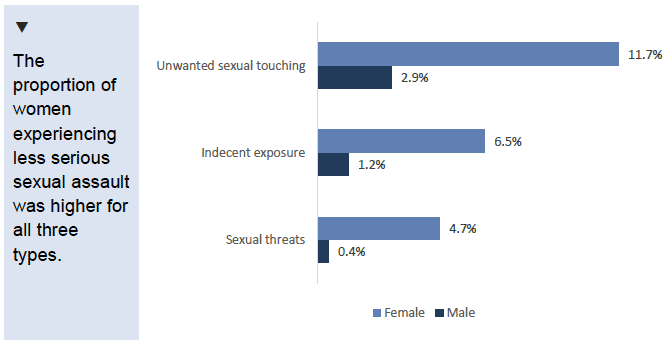
Base: All male respondents (4,360); all female respondents (5,240). Variable: SV_0.
The relationship between victims and offenders differs by type of less serious sexual assault.
Of those who had experienced indecent exposure since the age of 16, 73% said that the offender was someone they had never seen before. Strangers were also most likely to perpetuate unwanted sexual touching (40%). Indecent exposure and unwanted sexual touching were less likely to involve partners (6% and 17%, respectively) and ex-partners (4% and 7%, respectively).
In contrast, partners were most likely to be the perpetrators of sexual threats, with over two-fifths (42%) of those who had experienced sexual threats since the age of 16 saying the offender was their partner. 16% said the perpetrator had been an ex-partner.[167]
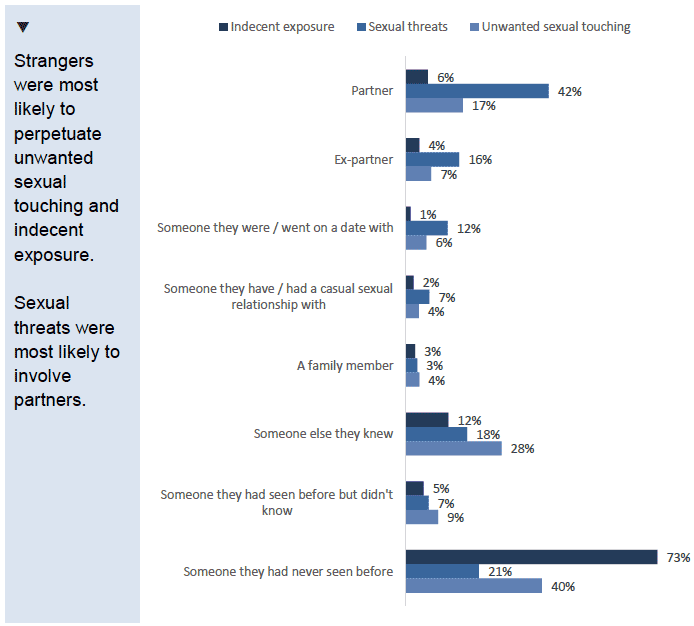
Base: All respondents who experienced unwanted sexual touching since the age of 16 (660); all respondents who experienced sexual threats since the age of 16 (260); all respondents who experienced indecent exposure since the age of 16 (380). Variables: TS_3; TS_5; ST_3; ST_5; INEX_3; INEX_5.
Are some population groups more likely to have experienced less serious sexual assault?
The proportion of respondents who reported experience of at least one form of less serious sexual assault since the age of 16 varied by age, gender and victim status[168] of the respondent.
Gender
Women were more likely than men to have experienced less serious sexual assault since the age of 16 (16.2% compared with 3.6%) and in the 12 months prior to interview (2.5% compared with 0.8%). The finding that women are more likely to experience less serious sexual assault than men is in line with the findings from 2008/09 and 2016/18.
The proportion of men and women experiencing each of the three types of less serious sexual assault also varied, as discussed earlier in this section.
Age
The proportion of those who had experienced less serious sexual assault both since the age of 16 and in the 12 months prior to interview decreased with age, as shown in Table 9.13, although there was no statistically significant difference between the two youngest age groups when looking at experiences since the age of 16.
These proportions have shown no change over time (both since 2008/09 and 2016/18).
| Age | Since age 16 | In the 12 months prior to interview | Base |
|---|---|---|---|
| 16 to 24 | 14.1% | 6.9% | 680 |
| 25 to 44 | 12.6% | 1.9% | 2,750 |
| 45 to 59 | 9.9% | 0.8% | 2,520 |
| 60 years and over | 6.2% | 0.1% | 3,650 |
Base: All respondents who have experienced at least one type of less serious sexual assault since age 16; all respondents who have experienced at least one type of less serious sexual assault in the 12 months prior to interview by age group. Variable: SV_0.
Victim status
Those who were classified as victims in the main SCJS survey were more likely to have experienced less serious sexual assault since the age of 16 than non-victims (16.0% compared with 9.3%). This is a consistent finding with the 2008/09 and 2016/18 results, despite an increase in the proportion of non-victims experiencing less serious sexual assault since 2008/09 (8.2%).
Area deprivation
As in previous years, there was no statistically significant difference in the proportion of respondents who had experienced less serious sexual assault since the age of 16 in terms of area deprivation.
However, the likelihood of experiencing less serious sexual assault for those living outside the 15% most deprived areas has increased between 2016/18 and 2018/20 (from 9.1% to 10.4%).
Rurality
There was no statistically significant difference in the proportion of respondents who had experienced less serious sexual assault since the age of 16 between those living in urban and rural areas. This is a consistent finding with previous results.
Contact
Email: scjs@gov.scot
There is a problem
Thanks for your feedback